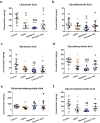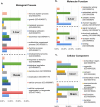Evaluation of bile salt hydrolase inhibitor efficacy for modulating host bile profile and physiology using a chicken model system
- PMID: 32188876
- PMCID: PMC7080769
- DOI: 10.1038/s41598-020-61723-7
Evaluation of bile salt hydrolase inhibitor efficacy for modulating host bile profile and physiology using a chicken model system
Abstract
Gut microbial enzymes, bile salt hydrolases (BSHs) are the gateway enzymes for bile acid (BA) modification in the gut. This activity is a promising target for developing innovative non-antibiotic growth promoters to enhance animal production and health. Compelling evidence has shown that inhibition of BSH activity should enhance weight gain by altering the BA pool, host signalling and lipid metabolism. We recently identified a panel of promising BSH inhibitors. Here, we address the potential of them as alternative, effective, non-antibiotic feed additives, for commercial application, to promote animal growth using a chicken model. In this study, the in vivo efficacy of three BSH inhibitors (caffeic acid phenethylester, riboflavin, carnosic acid) were evaluated. 7-day old chicks (10 birds/group) were either untreated or they received one of the specific BSH inhibitors (25 mg/kg body weight) via oral gavage for 17 days. The chicks in treatment groups consistently displayed higher body weight gain than the untreated chicks. Metabolomic analysis demonstrated that BSH inhibitor treatment led to significant changes in both circulating and intestinal BA signatures in support of blunted intestinal BSH activity. Consistent with this finding, liver and intestinal tissue RNA-Seq analysis showed that carnosic acid treatment significantly altered expression of genes involved in lipid and bile acid metabolism. Taken together, this study validates microbial BSH activity inhibition as an alternative target and strategy to antibiotic treatment for animal growth promotion.
Conflict of interest statement
The authors declare no competing interests.
Figures









Similar articles
-
Identification and characterization of a bile salt hydrolase from Lactobacillus salivarius for development of novel alternatives to antibiotic growth promoters.Appl Environ Microbiol. 2012 Dec;78(24):8795-802. doi: 10.1128/AEM.02519-12. Epub 2012 Oct 12. Appl Environ Microbiol. 2012. PMID: 23064348 Free PMC article.
-
A Gut-Restricted Lithocholic Acid Analog as an Inhibitor of Gut Bacterial Bile Salt Hydrolases.ACS Chem Biol. 2021 Aug 20;16(8):1401-1412. doi: 10.1021/acschembio.1c00192. Epub 2021 Jul 19. ACS Chem Biol. 2021. PMID: 34279901 Free PMC article.
-
Discovery of bile salt hydrolase inhibitors using an efficient high-throughput screening system.PLoS One. 2014 Jan 14;9(1):e85344. doi: 10.1371/journal.pone.0085344. eCollection 2014. PLoS One. 2014. PMID: 24454844 Free PMC article.
-
Bacterial bile salt hydrolase: an intestinal microbiome target for enhanced animal health.Anim Health Res Rev. 2016 Dec;17(2):148-158. doi: 10.1017/S1466252316000153. Anim Health Res Rev. 2016. PMID: 28155801 Review.
-
Bile salt hydrolases: Structure and function, substrate preference, and inhibitor development.Protein Sci. 2018 Oct;27(10):1742-1754. doi: 10.1002/pro.3484. Epub 2018 Sep 24. Protein Sci. 2018. PMID: 30098054 Free PMC article. Review.
Cited by
-
Another renaissance for bile acid gastrointestinal microbiology.Nat Rev Gastroenterol Hepatol. 2024 May;21(5):348-364. doi: 10.1038/s41575-024-00896-2. Epub 2024 Feb 21. Nat Rev Gastroenterol Hepatol. 2024. PMID: 38383804 Free PMC article. Review.
-
Dietary supplementation with mulberry leaf flavonoids and carnosic acid complex enhances the growth performance and antioxidant capacity via regulating the p38 MAPK/Nrf2 pathway.Front Nutr. 2024 Jul 30;11:1428577. doi: 10.3389/fnut.2024.1428577. eCollection 2024. Front Nutr. 2024. PMID: 39139650 Free PMC article.
-
Characterization of substrate specificity and inhibitory mechanism of bile salt hydrolase from Lactobacillus reuteri CRL 1098 using molecular docking analysis.Biotechnol Lett. 2021 May;43(5):1063-1073. doi: 10.1007/s10529-021-03097-y. Epub 2021 Feb 16. Biotechnol Lett. 2021. PMID: 33591463
-
Metabolic control by the microbiome.Genome Med. 2022 Jul 29;14(1):80. doi: 10.1186/s13073-022-01092-0. Genome Med. 2022. PMID: 35906678 Free PMC article. Review.
-
Dimethyl Sulfoxide: Morphological, Histological, and Molecular View on Developing Chicken Liver.Toxics. 2021 Mar 12;9(3):55. doi: 10.3390/toxics9030055. Toxics. 2021. PMID: 33809222 Free PMC article.
References
-
- Moore P, et al. Use of sulfasuxidine, streptothricin, and streptomycin in nutritional studies with the chick. J. Biol. Chem. 1946;165:437–441. - PubMed
Publication types
MeSH terms
Substances
LinkOut - more resources
Full Text Sources

